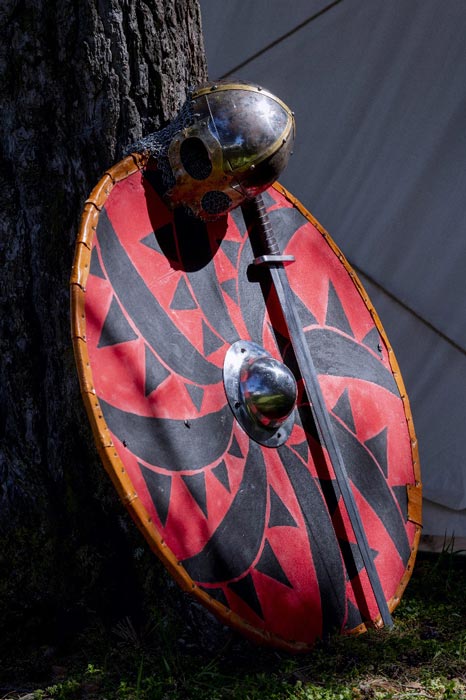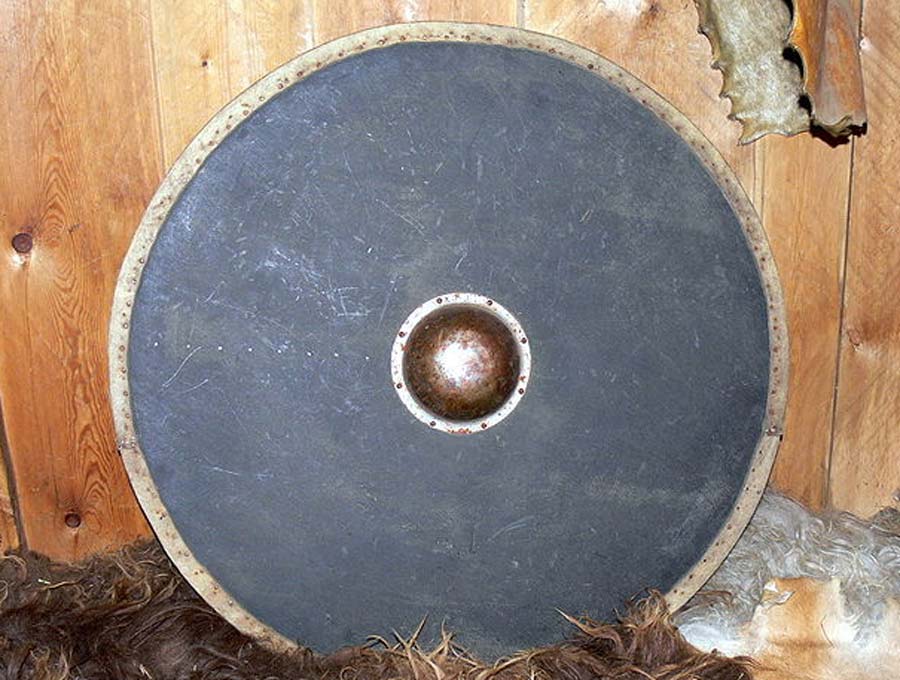In Northern Europe, Vikings raiders made good use of shields in their battles. These shields were made of wooden boards covered with stretched animal skins.
Previously, these covers were thought to be added for purely aesthetic reasons. However, the new research has demonstrated that the shield covers had a more practical purpose, increasing the strength and improving the structural integrity of the shield.
The History of Viking Shields
The shields constructed by the Vikings had their origins back in the Iron Age. The shields were built of thin planks formed into circular shapes. In the middle, a dome made of iron is present to safeguard the hand of the shield-bearer.
The dome is known as shield “boss”, and it is often the only part of a shield that survives down the centuries for archaeologists to find. The design of the boss varied through the Iron Age and into the Viking period, and the remains of a shield can often be dated by analyzing the shield boss.
These shield bosses are most commonly discovered in graves where Viking warriors are buried with their arms and armor, to accompany the Viking on their journey to the afterlife.
A New Study
The typical Viking shield used animal skin to stretch over the wooden structure. This appears to have provided the shield with additional strength, as the leather would have acted similarly to modern-day plastics. As the skin cured and shrunk it would have packed the wood closely together.

The shields would vary in robustness, structure, and many other properties depending on the type of animal species utilized, and the way the skin had been treated. Now, an analysis of surviving Viking shields has solved the mystery of which skin product types were used, providing for the first time complete information about what a Viking shield looked like.
A microanalysis was conducted on samples from four shields dating from 350 BC to 1000 AD. This allowed researchers to uncover which animal skins were preferred, and what treatment was applied to the leather. The wide range in dates also allowed for an analysis of changes and improvements to shield technology.
The shields were all from archaeological finds in Scandinavia. These include Borremose (near Aars in Denmark), dated around 350 BC, Baunegård (on the Danish Baltic island of Bornholm) around 250-300 AD, and Birka (a trading post near Stockholm in Sweden) around 900-1000 AD. The analysis also included finds dated to around 875 AD from Latvia.
The Evolution Of Shield Design
The findings showed that the Borremose shield was created from cattle skin and was possibly tanned using tannins from oak bark. It also revealed that the later Baunegård leather was not tanned, but instead was stretched over the frame, and contained cinnabar traces.
The Latvian Tira shield was also not tanned, but appeared to have been treated to become water-resistant and hard. The most recent shield, from the Birka site, was the only one made with sheep leather instead of cattle, although it retained a cattle leather rim. It is believed that this denser leather on the rim was used to deflect slashing attacks from bladed weapons, while the sheepskin front would keep the weight of the shield down.
Given only four shields were included in the analysis, it is difficult to provide any conclusive statements concerning chronological and regional variations. But the study has revealed a host of new details and provided a framework against which new shield discoveries can be compared.
More Than Just A Pretty Fascia?
Despite the small sample size, the results implied that the hides were selected carefully. The products were also treated in varying ways before placing them on the shields and using them in combat.
The techniques of combat and tactics of battle were likely to be highly influenced by the way these shields performed. Therefore, precise attention was provided to every aspect of shield craftsmanship during the construction.
The fantastically-titled “combat archeologist” from the University of Copenhagen, Rolf Warming, is working on his masters thesis on the Viking Age’s martial practices. Based in part on this study, he revealed the new theory about the way Vikings survived on the battlefields.

Survival appears to have been much more dependent on shields than chain mail or helmets. To test his theory, Warming recreated a Viking shield in a round form, based on archaeological discoveries from Viking battlefields in Denmark, Sweden, and Norway.
The recreation measures about one meter (3 feet) in diameter, and was made using pine planks. The planks were then covered with pig leather and were treated in a similar way to historical shields. The shield was rimmed with ox rawhide.
While it may sound that the round shield would be more protective, Rolf Warming discovered that a round shield would quickly fall apart when hit directly from the front. This vulnerability meant that the shield could not have been primarily used this way, at it would have quickly become ineffective.
However, things were completely different when he utilized the shield not as a defensive tool but as an offensive tool. The reinforced edge of the shield could be used to deliver blows to an opponent, to be followed up with axe or sword.
This also helped explain the fact that shield bosses often had peculiar dents on them, a fact that had puzzled archaeologists. Warming’s research provided them with answers, in that incoming blows could be deflected onto the boss, the strongest part of the shield. Additionally, with the shield having an offensive function, dents were much more likely.
Perfect For The Job In Hand
With the mystery of the ways a shield functioned in battles now solved, it is now possible to construct an accurate shield replica for the first time. A shield has been constructed on the basis of the new research and is tested as one part of the SoCA project in partnership with Trelleborg Viking Fortress present at Denmark’s National Museum.
The shield was an authentic replica in which all components were referenced to the archaeological data, including the skin. The rim as well as facing were tanned and were created based on samples taken from the Viking Age shield found in Birka, Sweden.

The rim was prepared from the leather of cattle, while the shield was prepared from the sheep’s leather. A possible reason for using sheepskin for construction may be due to its particular capacity for water resistance.
The traditional tanning process resulted in leathers with a very different quality compared to the modern ones. Due to the rough shape of the leather, the shields were more shock-absorbent and obstructed all blade alignments while deflecting strong cuts.
The shield, if used properly, was able to absorb damage and remain completely functional, protecting its user from spears, arrows, and sword attacks. The experimental trials highlighted the necessity to apply the skin on much thinner shields and shows the level of sophistication in their construction.
Top Image: Viking shields were highly sophisticated and specialized. Source: Alex_marina / Adobe Stock.
By Bipin Dimri